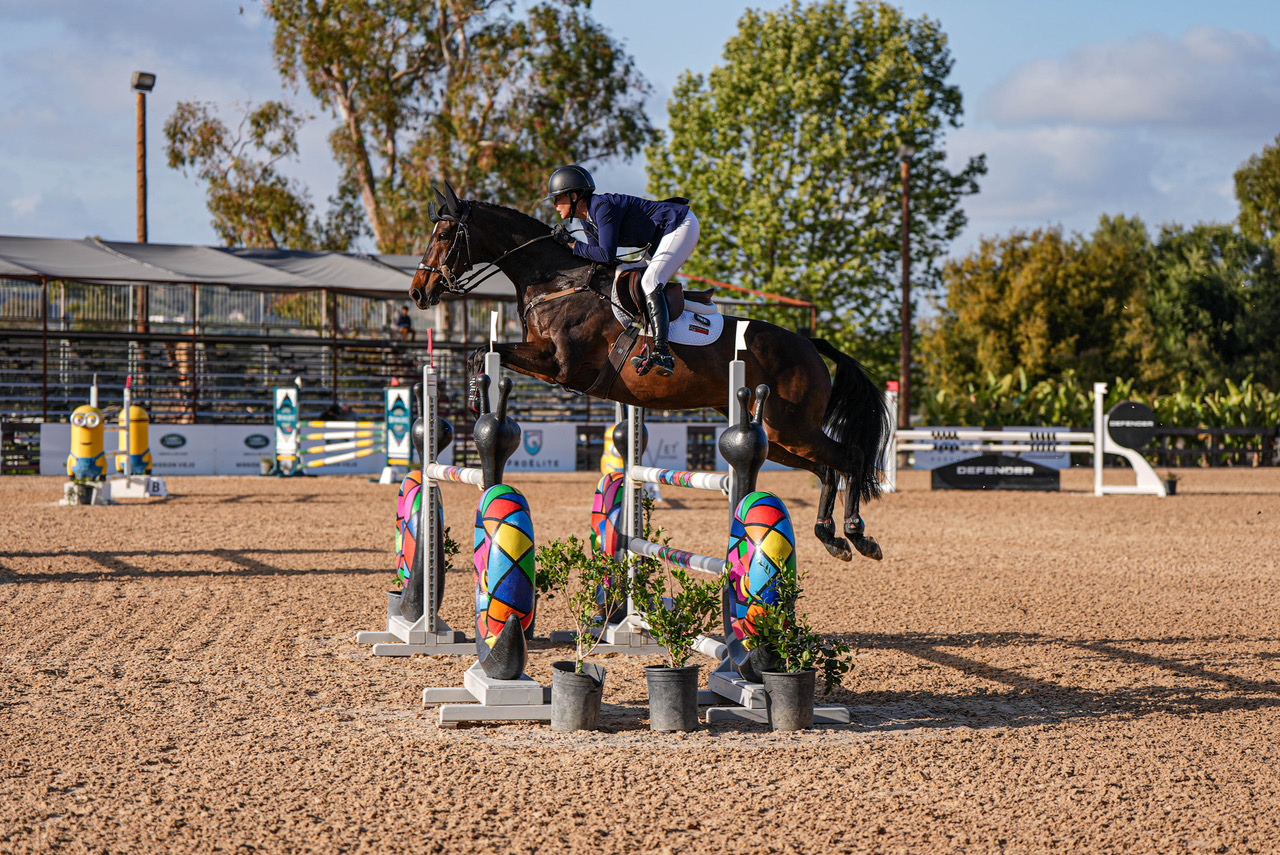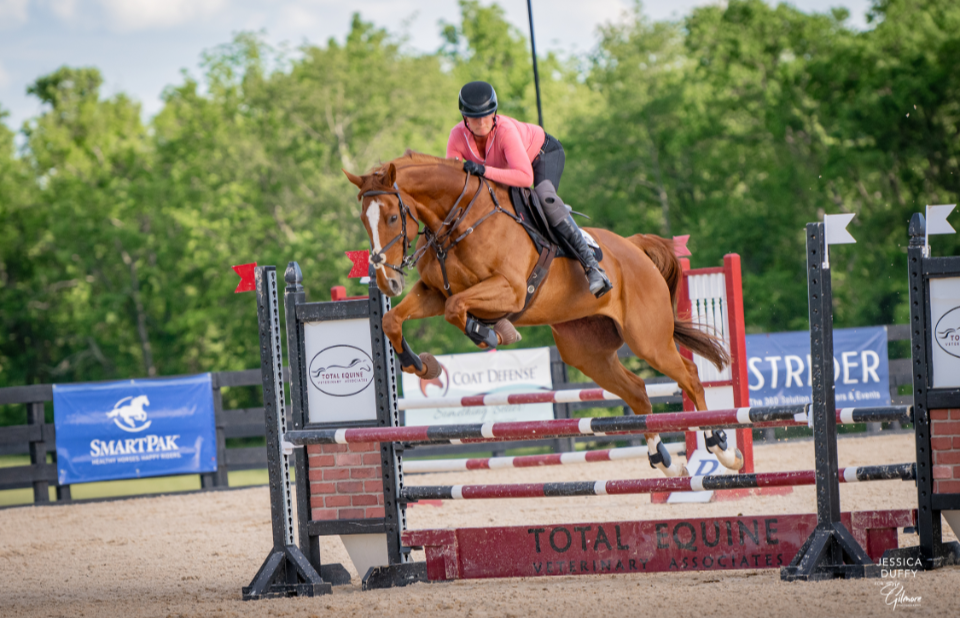Spring is a time to prepare for what’s ahead and many of this week’s International Horse Trials contenders took full advantage of ideal opportunities to build confidence, confirm training and find out where they can push the edges of their horse’s performance.
Bec Braitling’s plan to “run quick here” with Caravaggio II was part of a shake-up in the CCI4*-S standings. Tommy Greengard and That’s Me Z moved from 6th to 2nd and Megan McIver and Igor B kept their overnight third rank.
Prepping for a return to the Defender Kentucky CCI5-L next month, Braitling and Caravaggio stepped up from 4th after Friday’s dressage and show jumping. It helped that the overnight leaders, Tamie Smith and Kynan, took it easy timewise over Clayton Fredericks’ widely praised cross-country course.
The California-based Australian rider was thrilled with their 30.4 dressage score, though less so with an uncharacteristic rail in show jumping. European show mileage last year accelerated Braitling’s ability to “be brave with his really big stride,” she said of their final phase performance. “He sets himself up really well and I’m learning to not mess it up!” At 6:44 minutes, they were the fastest 4* finishers, incurring 13.2 time penalties.
“I get excited when I see a course I can get a lot out of,” Brailting explained. “I loved the flow. It was really good with distances that helped me with forward riding. And plenty of places to challenge me to be brave in the turns.”
The win gives Braitling 40 qualifying point for the USEF Open of Eventing, set for Morven Park in Virginia in October. “It’s definitely a big goal for this year.”
“It’s safe to say that Z blew everybody’s expectations away,” said Tommy Greengard of That’s Me Z. The 8-year-old Zangersheide has been a young horse superstar and continued that trajectory in his first Advanced level outing. “I felt like he was well prepared for the level, but you never know,” said Greengard. “He finished as well as he started.”
Of the track, the partner in Andrea Pfeiffer’s Chocolate Horse Farms acknowledged that the quantity of challenging corner lines “made me a little nervous. But once he jumped the 8AB Galway Leap/Corner so well, I had a good feeling.”
Megan McIver celebrated her one-year partnership with Igor B, a 12-year-old Dutch Warmblood. They debuted at this show last year by winning the CCI2*-S and ended their year 2nd in the CCI3*-L here in the fall. Recent work with former US eventing coach Eric Duvander has “completely revolutionized how my horses do dressage,” McIver shared. Their 30.8 dressage effort reflected Duvander’s emphasis on “thoroughness and keeping him loose and supple” to excellent effect.
The Northern California-based professional had penciled in next month’s Kentucky pending how well things went this week. “I give serious credit to Clayton (Fredericks’) design. A 4* never feels easy, but I think all the challenges were right where they should be.”
McIver plans to hit Kentucky now, as does Tamie Smith with her overnight leader Kynan. They took their time today to finish 5th. “We had to keep the cat in the bag until it’s time to let him out,” said Smith.
Sitting second overnight, Washington-based professional Karen O’Neal and Clooney 14 had the win in their sights until a heartbreaking run-out at the C element of fence 22 – the coffin combination.
CCI3*-S: Smith and Lillet 3 Light It Up
Smith went from cruising on Kynan in the 4* to crushing it with Lillet 3 in the 3*. Tommy Greengard had just 1.6 time faults with Balladeer Kilbrickens Lad, who had risen from 7th after dressage and 4th after show jumping. Erin Kellerhouse and Bon Vivant GWF held their third-place position with 5.6 time penalties.
Three seconds under the 5:33 optimal time, Smith and Lillet were the only double clear cross-country duo in this 33-horse field. “She’s amazing, so rideable and just super,” Smith raved of the 9-year-old Holsteiner. “The course was tough. There were a number of combinations that were quite strong, but it was super easy for her.”
Tommy Greengard sat second overnight with Joshuay MBF, but it was lesser-known Balladeer Kilbrickens Lad who zipped into 2nd place. The 10-year-old Irish Sport Horse came to Chocolate Horse Farm’s program less than a year ago with “severe confidence issues,” Greengard said. “He’s new to the upper levels and is just going from strength to strength.”
Greengard took a smooth, leisurely pace with Joshuay, slipping to 11th place. “Everything went exactly to plan,” said Greengard of his two 3* rides, two of the nine horses he competed week. His equine quiver included Open Preliminary Champion MBF Google.
Erin Kellerhouse and Bon Vivant GWF were “getting our mojo back on” after a bad fall last season. In his return to the 3* level, the 10-year-old Oldenburg put in one of his best dressage tests on Friday. “He was with me the whole way. He’s comfortable with this level of work and it’s nice to go into the ring being able to ride for things, rather than just manage them.”
After double-clear show jumping, Bon Vivant was cool over a cross-country course that Kellerhouse admits gave her some pause. “There were three or four hard combinations, but he didn’t care.” Five golf carts of cheering Kellerhouse fans racing alongside their route may have helped, too. “I hear them for sure and that’s been fun!”
Kellerhouse also finished 4th with Ringwood Adios Amigo, a 9-year-old Irish Sport Horse.
CCI2*-S: Smith Keeps Top Two Spots
Kareena K and Solaguayre Cantata kept earning their rider Tamie Smith’s high praise. The 9-year-old Holsteiner mare and the 7-year-old Argentine Thoroughbred finished 1st and 2nd and stayed on their 23.2 and 27.4 dressage scores.
“They were both unbelievable,” said Smith. “It was the first 2* for both and it was a strong one. They answered all the questions.”
Washington-based Anni Grandia-Dodson and Mistral, a 9-year-old German Sport Horse, moved up from 11th to 3rd. “It’s our first time out for the season and our first time finishing on our dressage score at this level,” she said. “Today’s course was really inviting and a great gallop for my horse to start the season. There were lots of great questions, but it wasn’t overly technical.”
CCI1*-S – Kaylawna Smith-Cook Keeps Lead
Kaylawna Smith-Cook and Coco Chanel, a 7-year-old Holsteiner, kept it flawless to finish on Friday’s 31.5 dressage effort. A new ride in the young professional’s promising string, Coco Chanel “is gorgeous and she knows it,” said Smith-Cook. The mare had some 2* experience in her native Belgium, but it was mostly the feeling she gave that sold her. “I just felt like she was my horse and that’s not a feeling I’ve had very often.”
Like her mother Tamie Smith, Smith-Cook works monthly with Australian show jumper Scott Keach. She credits him with solidifying her jumping fundamentals for the benefit of all the horses she’s bringing along. Having horses of very high quality helps, too, and Coco Chanel is in that camp.
“She has a little spook in her, and the 1* cross-country was pretty tricky today. But she handled everything just wonderfully.”
Asia Vedder and Litmanen Z, a 7-year-old Zangersheide, finished 2nd, with Megan McIver and Storm Dino, a 6-year-old Irish Sport Horse, in 3rd before cross-country.
Tomorrow’s Stars
The International Horse Trials concluded today, with Starter through Open Training divisions concluding Sunday. Saturday celebrations started shortly after the CCI4* ended as adorable pony riders, brave advanced age equestrians and everything in between took to the Grand Prix Arena for Starter division show jumping.
Raucous cheers and encouragement celebrated the common denominator across all this week’s divisions – a love for the horse and the sport eventing and its community.
CCI3*-S and CCI4*-S divisions are available on-demand for Equestrian+ subscribers. Commentators Frankie Thieriot-Stutes and Spencer Sturmey of Great Britian share their insights and expertise in all phases.
Galway Downs International H.T. (CA): [Website] [Live Stream Replays] [Scores]


















































